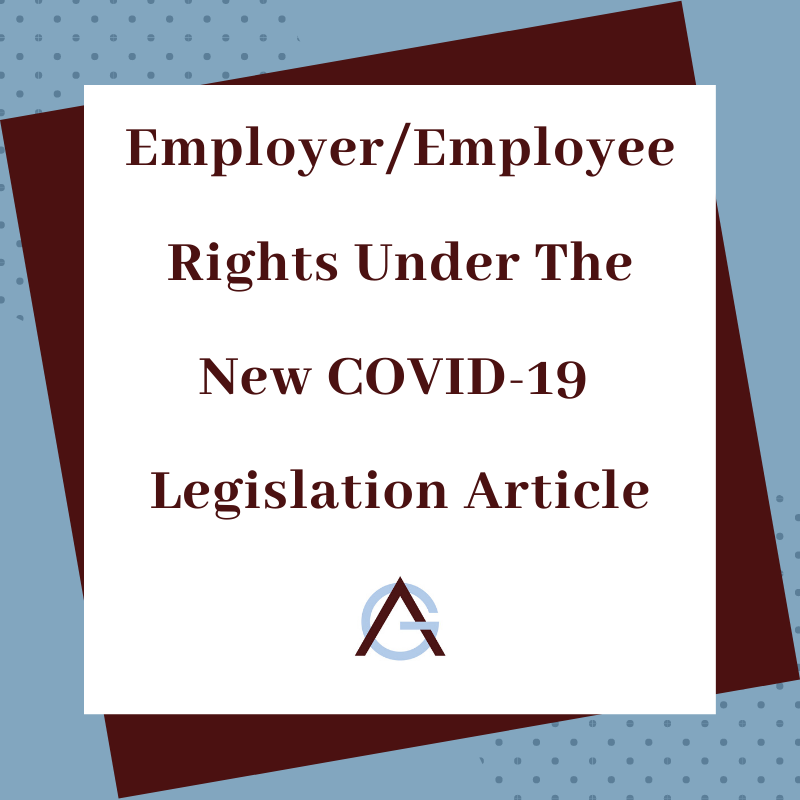In the wake of the coronavirus pandemic, Congress enacted legislation to assist U.S. workers and to define an employer’s new obligations to those workers. Some important new laws include the Families First Coronavirus Response Act (“FFCRA”), the Emergency Family Medical Leave Act (“EFMLA’), and the Emergency Paid Sick Leave Act (“EPSLA’). These laws can be nuanced, fact specific, and at times confusing. Our law firm assists employers and employees in understanding their rights, and would be happy to answer your questions during these difficult and uncertain times.
FFCRA
The FFCRA sets up a system whereby employees have, under certain circumstances, entitlement to paid leave by covered employers, as implemented through the EFMLA and the EPSLA. The Department of Labor has prepared a poster regarding employee rights, which employers should post in a conspicuous place: https://www.dol.gov/sites/dolgov/files/WHD/posters/FFCRA_Poster_WH1422_Non-Federal.pdf.
Generally, the Act provides that employees of covered employers are eligible for:
Two weeks (up to 80 hours) of paid sick leave at the employee’s regular rate of pay where the employee is unable to work because the employee is quarantined (pursuant to Federal, State, or local government order or advice of a health care provider), and/or experiencing COVID-19 symptoms and seeking a medical diagnosis; or
Two weeks (up to 80 hours) of paid sick leave at two-thirds the employee’s regular rate of pay because the employee is unable to work because of a bona fide need to care for an individual subject to quarantine (pursuant to Federal, State, or local government order or advice of a health care provider), or to care for a child (under 18 years of age) whose school or child care provider is closed or unavailable for reasons related to COVID-19, and/or the employee is experiencing a substantially similar condition as specified by the Secretary of Health and Human Services, in consultation with the Secretaries of the Treasury and Labor; and
Up to an additional 10 weeks of paid expanded family and medical leave at two-thirds the employee’s regular rate of pay where an employee, who has been employed for at least 30 calendar days, is unable to work due to a bona fide need for leave to care for a child whose school or child care provider is closed or unavailable for reasons related to COVID-19.
EFMLA
The EFMLA expands the Family Medical Leave Act (“FMLA”) to allow for paid leave, subject to various conditions, caps, and limitations. For the EFMLEA to apply, the issue is whether there is a qualifying reason, namely because of the need to take care of a son or daughter whose school or daycare is closing or unavailable because of the coronavirus.
EPSL
The EPSL provisions of the FFCRA allow eligible full-time employees to take up to 80 hours of paid sick leave between April 1 and December 31, 2020, for one of the six enumerated reasons set forth in the Act, which are:
i. if the employee is subject to a federal, state, or local quarantine or isolation order related to COVID-19;
ii. if the employee has been advised by a health care provider to self-quarantine due to concerns related to COVID-19;
iii. if the employee is experiencing the symptoms of coronavirus and seeking a medical diagnosis;
iv. if the employee is caring for “an individual” (need not be a family member) who is subject to an order described in (1) above or has been advised to self-quarantine, as described in (2) above;
v. if the employee is caring for a son or daughter under the age of 18 because such son or daughter’s school or place of care has been closed, or such son or daughter’s care provider is unavailable due to coronavirus; or
vi. if the employee is experiencing any other “substantially similar condition” specified by the Secretary of Health and Human Services in consultation with the Secretary of the Treasury and the Secretary of Labor.
Unemployment
Employees who have been laid off or furloughed may apply for unemployment.


Comments
Comments are closed.